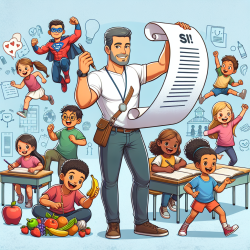Introduction
The INVestigating traIning assoCiated blasT pAthology (INVICTA) study, as presented in the research article by Roy et al. (2022), offers a comprehensive methodology for assessing brain function in military personnel exposed to blast events. This blog aims to translate the insights from the INVICTA study into actionable strategies for speech-language pathologists (SLPs) working with children, particularly in the context of online therapy services provided by TinyEYE.
Key Methodological Insights
The INVICTA study employs a multi-faceted approach to assess brain function, including neurocognitive, neurosensory, neuromotor, and autonomic nervous system assessments. These methodologies can be adapted to improve pediatric speech-language pathology practices. Here are some key takeaways:
- Neurocognitive Assessments: The use of standardized tests like the Hopkins Verbal Learning Test – Revised (HVLT-R) can be adapted for children to assess verbal learning and memory. Incorporating similar assessments in online therapy can help track progress and identify areas needing intervention.
- Neurosensory Evaluations: The Brain Gauge device used in the INVICTA study measures tactile neurosensory function. SLPs can use similar tools to assess sensory processing issues in children, which often co-occur with speech and language disorders.
- Neuromotor Performance: The AccWalker assessment, which measures dynamic balance, can be adapted to evaluate motor skills in children. This is particularly useful for children with co-occurring motor and speech disorders.
- Blood Biomarkers: While blood biomarker analysis is more invasive, understanding its potential can guide future research in pediatric populations to identify underlying physiological issues contributing to speech and language disorders.
Implementing INVICTA Insights in Pediatric SLP
To enhance outcomes for children, SLPs can implement the following strategies based on the INVICTA study:
1. Standardized Testing
Incorporate standardized neurocognitive tests into your practice to objectively measure progress. Tools like HVLT-R can be adapted for younger populations to assess memory and learning capabilities.
2. Sensory Processing Assessments
Utilize sensory processing assessments to identify children with sensory integration issues. This can help tailor interventions that address both sensory and language needs.
3. Motor Skills Evaluation
Incorporate motor skills assessments into your practice. Tools like the AccWalker can be adapted to evaluate balance and coordination, which are often linked to speech production capabilities.
4. Data-Driven Decisions
Use data from these assessments to make informed decisions about intervention strategies. Regularly track progress and adjust therapy plans based on objective data.
Encouraging Further Research
The INVICTA study highlights the importance of comprehensive, multi-modal assessments in understanding brain function. SLPs are encouraged to engage in further research to explore the applicability of these methodologies in pediatric populations. Collaborating with researchers can lead to the development of new tools and strategies that improve outcomes for children with speech and language disorders.
Conclusion
The INVICTA study provides valuable insights that can be adapted to enhance pediatric speech-language pathology practices. By incorporating standardized testing, sensory processing assessments, motor skills evaluations, and data-driven decision-making, SLPs can create more effective intervention plans. Engaging in further research will continue to advance the field and improve outcomes for children.
To read the original research paper, please follow this link: Methodology of the INVestigating traIning assoCiated blasT pAthology (INVICTA) study.










